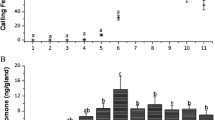Abstract
This study was performed on virgin females ofCulicoides nubeculosus to determine sites of production and emission of sex pheromone. The ventral abdominal surface is the site of emission of the pheromone. Morphologically there is evidence of the presence of abdominal atrichial areas. The abdominal areas, eight per segment (four ventral and four dorsal), are covered by a cuticle devoid of micro- and macrotrichiae. The dorsal and ventral areas differ considerably in their structure. The dorsal atrichial areas have an unperforated cuticle covering a normal epidermis, whereas the ventral atrichial areas have a cuticle perforated by numerous tubular structures, with a loosely organized procuticle and no underlying epidermal cells. A pair of voluminous cells with the classical ultrastructural characteristics of enocytes is invariably located in the vicinity of the ventral atrichial areas. These cells undergo ultrastructural modifications tending towards involution according to the age of the insects, being correlated with the decrease in pheromone emission by older females. The hypothesis is put forward that enocytes are involved in pheromone production.
Similar content being viewed by others
References
Boorman, J. 1974. The maintenance of laboratory colonies ofCulicoides variipennis (Coo),C. nubeculosus (Mg) andC. riethi (Kieff.). Diptera Ceratopogonidae.Bull. Entomol. Res. 64:371–377.
Gassier, P. andFain-Maurel, M.A. 1972. Caracteres infrastructuraux et cytochimiques des oenocytes deLocusta migraloria migratorioides en rapport evec les mues et les cycles ovariens.Arch. Anat. Microsc. 61:357–380.
Clearwater, J.R., andSarafis, V. 1973. The secretory cycle of a gland involved in pheromone production in the noctuid moth.,Pseudaletia separata.J. Insect Physiol. 19:19–28.
Crossley, A.C., andWaterhouse, D.F. 1969. The ultrastructure of a pheromone secreting gland in the male Scorpion-flyHarbobittacus australis (Rittacidae: Mecoptera).Tissue Cell 1:273–294.
Delachambre, M.J. 1966. Remarque sur l'histophysiologie des oenocytes epidermiques de la nymphe deTenebrio molitor L.C.R. Acad. Sci (Paris) 263:764–767.
Diehl, P.A. 1975. Synthesis and release of hydrocarbons by the oenocytes of the desert locust,Schistocerca gregaria.J. Insect Physiol. 21:1237–1246.
Dillwith, J.W., Blomquist, G.J., andNelson, D.R. 1981. Biosynthesis of the hydrocarbon component of the sex pheromone of the house-flyMusca domestica L.Insect Biochem. 11:247–253.
Howard, R.W., andBlomquist, G.J. 1982. Chemical ecology and biochemistry of insect hydrocarbons.Annu. Rev. Entomol. 27:149–172.
Ismail, M.T., andKremer, M. 1980. L'effet du repas sanguin sur la production de pheromone para les femelles deCulicoides nubeculosus (Diptera: Ceratopogonidae).Ann. Par. Hum. Comp. 55:445–466.
Ismail, M.T., andKremer, M. 1983. Dtermination of the site of pheromone emission in the virgin femaleCulicoides nubeculosus Mg. (Diptera: Ceratopogonidae).J. Insect Physiol. 29:221–224.
Kremep, M., Ismail, M.T., andRebholtz, C. 1979. Detection of a pheromone released by the females ofCulicoides nubeculosus (Diptea: Ceratopogonidae) attracting the males and stimulating copulation.Mosq. News 39:627–631.
Locke, M. 1969. The ultrastructure of the oenocytes in the molt-intermolt cycle of an insect.Tissue Cell 1:103–154.
Percy, J.E., andWeatherston, J. 1974. Gland structure and pheromone production in insects.Front. Biol. 32.
Rinterknecht, E., Porte, A., andJoly, P. 1969. Contribution a l'etude ultrastructurale de l'oenocyte chezLocusta migratoria.C.R. Acad. Sci. (Paris) 269:2121–2124.
Romer, F. 1980. Histochemical and biochemical investigations concerning the function of larval oenocytes ofTenebrio molitor L. (Coleoptera, Insecta).Histochemistry 69:69–84.
Schlein, Y., Galun, R., andBeneliahu, M.N. 1980. The legs ofMusca domestica andGlossina morsitans females as the site of sex pheromone release.Experientia 36:1174–1175.
Wattebled, S., Bitsh, J., andRousset, A. 1978. Ultrastructure of pheromone producing eversible vesicles in males ofChrysopa perla L. (Insecta, Neuroptera).Cell. Tissue Res. 194:481–497.
Author information
Authors and Affiliations
Rights and permissions
About this article
Cite this article
Ismail, M.T., Zachary, D. Sex pheromones inCulicoides nubeculosus (diptera, ceratopogonidae): Possible sites of production and emission. J Chem Ecol 10, 1385–1398 (1984). https://doi.org/10.1007/BF00988120
Received:
Revised:
Issue Date:
DOI: https://doi.org/10.1007/BF00988120




